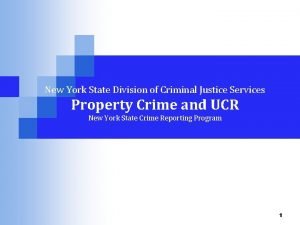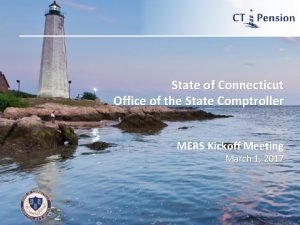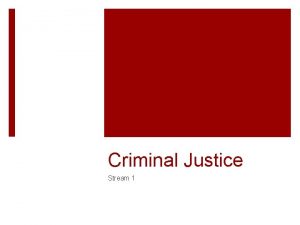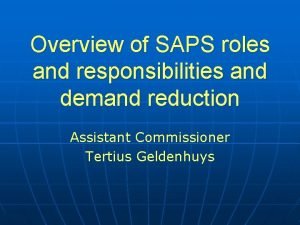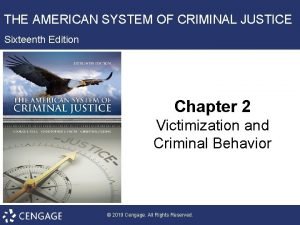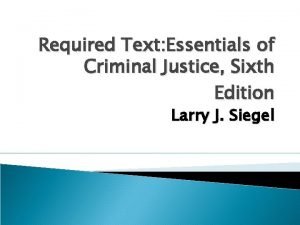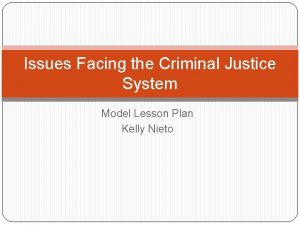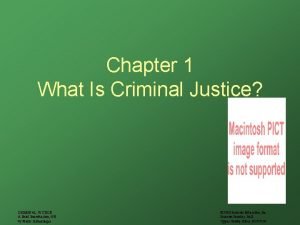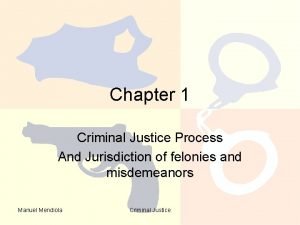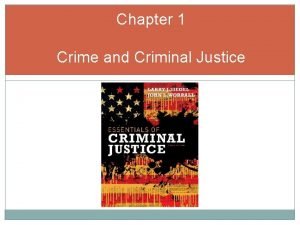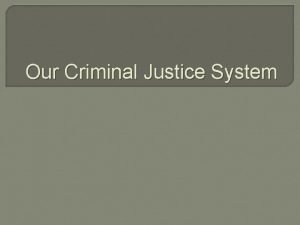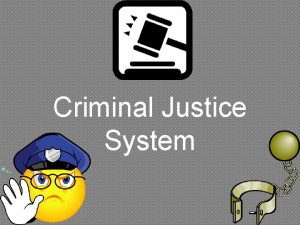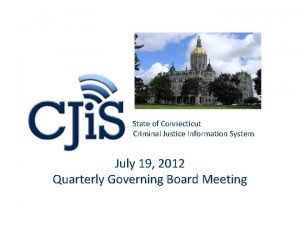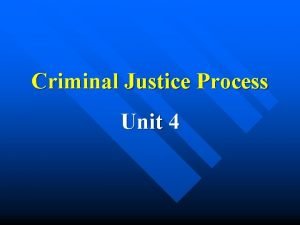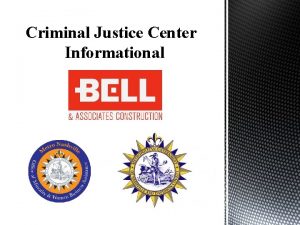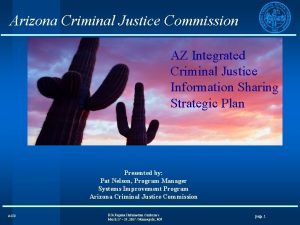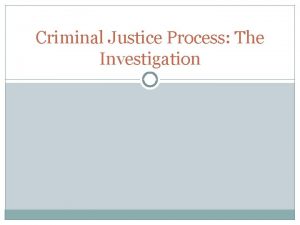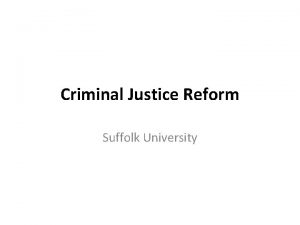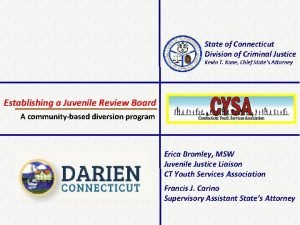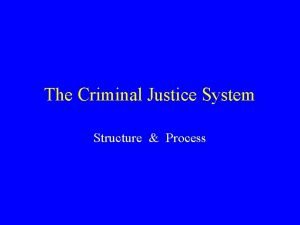State of Connecticut Criminal Justice Information System Connecticut























- Slides: 23

State of Connecticut Criminal Justice Information System Connecticut Information Sharing System (CISS) Technology Workshop 1: Data Replication/ETL August 23, 2012

Data Replication/ETL: Terms Data Replication: Replication Data Replication is the process of copying the data from a certain data source to another source while maintaining identical copies of the data that are synchronized. Extraction, Transformation, and Load (ETL): (ETL is the process of extracting data from an environment, transforming elements, and loading the data into an environment. August 23, 2012 2

Data Environments Data structures have transformed since the storing of information began. In many cases, earlier file-based data still exists today. This is most common with IBM and DEC (Compaq/HP) environments. The ability to access information, from any type of data environment and to replicate it into a common structure, is vital to the success of CISS. The CISS community currently supports data structures ranging from flat and indexed files on IBM and HP mainframe/supermini systems to databases including SQL Server, Oracle, Microsoft Access; there is even a Lotus Notes application within our world. August 23, 2012 3

Document Your Data August 23, 2012 4

Move Data to the Right Database August 23, 2012 5

Transforms Data as it Moves it August 23, 2012 6

Replication/ETL Requirements • • Linking connected/disconnected “Clouds of data” into unified target environment(s) with or without naming transformations Supports direct integration of legacy data into any relational database Facilitates Automated Data Synchronizing o Highly customizable o Automated failure control o Unlimited capabilities including scripting, triggers, external applications o Immediate integration with Niem naming conventions via templates Eliminates resources (coding) o No legacy coding structures o No user-developed coding points of failure o Widely utilized technologies (adopted by Federal and State Agencies) o Facilitates RAD concepts o Single point of maintenance/configuration Automates information streams (indexes, partial, incremental, full) Supports most commonly used DBs and data file structures o Oracle, SQL Server, RMS, DB 2, VSAM, ISAM, Sequential, Indexed, Adabase, Lotus Notes Group entities (agencies, tables, files, etc. ) August 23, 2012 7

Replication/ETL Requirements, cont’d. Data Replication/ETL Data replication/ETL is a vital component of the CISS architecture in that it enables the indexing of agency data elements from a common, secured environment. The ability to index replicated data supports the ability for Microsoft’s FAST product to build and update an index using a singular data structure, SQL Server. Relevance to CISS One of the primary goals of CISS is to enable an individual, with proper credentials, to rapidly retrieve searched data across a spectrum of diverse information from 200+ CISS stakeholder business systems. The implementation of a well-designed and structured architecture that replicates, maps to NIEM, indexes, and presents data from such an expansive environment with <5 second response time will ensure this goal is achieved. August 23, 2012 8

Replication Options There are three options from which Agency Stakeholders can choose to support CISS searching their data environments. The three options give our CISS community flexibility to decide what method to use, each with differing levels of complexity for integration. Ø Federated Search Ø Agency Replicates Data Ø Crawling of their Data 9 10/30/2020

Replication – Option 1 • Data from a stakeholder’s environment is access from CISS via web service query. The agency will be required to create Web Service interfaces to be used by CISS. These services will respond to query requests from CISS, which will generate data extractions via views, stored procedures, or other methods an agency prefers to use. • The selected data will then be returned via the original request, synchronously. Each table to be searched by CISS will require a distinct Web Service. • This option requires the most effort by the agency and CISS and impacts the ability of CISS to respond to a query request rapidly. In effect, CISS does not recommend this option unless it is absolutely necessary to interface in this manner. For each search request made by a user within CISS, each of the agencies will be required to respond to a search request via web services and respond with the appropriate data. These queries are for initial search requests and detail requests. • As an example: if there are 5, 000 search requests (initial or detail) per hour, the agencies using Option 1 will be required to respond to each request – receive the request, query their data environments, build an XML message, and send the response via web service response. This scenario will significantly impact agency storage throughput, both theirs and the State of Connecticut’s network, affects Search response times and is a significant point of maintainability and failure in the Search segment of CISS. August 23, 2012 10

Replication – Option 2 • Data from a stakeholder’s environment is replicated (copied) by the agency and either put on a common network drive for CISS Access, placed on a FTP site for CISS to retrieve, or put into another data environment where CISS can replicate the data. A schedule to support collecting the replicated data will be arranged between CISS and the respective agencies. This option requires an effort by an agency to provide a mechanism to extract portions of their data into one of several structures (Database, index or flat file, XML, etc. ) and to make the data available to CISS. • • • Disadvantages to this option include delays in indexing and searching stale data, storage requirements for the agency to “hold” the replicated data and the repetitive process of building container(s) to retrieve updated data records. • If the agency cannot identify the changed records efficiently, then the entire database (only necessary fields) will need to be replicated, repetitively, throughout the day. • Lastly, the overhead and impact to re-index all the data from an agency will impact the agency’s and CISS’s systems and the State of Connecticut’s Network. August 23, 2012 11

Replication – Option 3 • This option is the most efficient scenario, and lowest impact to the stakeholder, CISS and the State of Connecticut’s networks. • It offers the ability to support agency governance of data, encryption of data, minimized network traffic, a single point of configuration, auditable, and secure. • To support this option, an agency works with CISS to: o o o • identify the pertinent data to be replicated (tables, fields, data files, etc. ), provides a User ID/Password with Read-Only access to their data environment (SQL, Oracle, O/S) and depending on their data environment, may be required to install a listener service. The listener service applies to VAX/Alpha systems and IBM environments using VSAM/ISAM for their data file structures. Oracle and SQL Server environments require only access to their respective Database’s IP Port Number (Oracle=1521, SQL Server=1433) This option enables CISS to scan the agency’s selected data environments on a predetermined schedule. Data environment which have high frequencies of updated data will be scanner frequently and those environments which have minor updates or are stale will be scanned infrequently. The frequency in either scenario depends on the size of the database, the nature of the data and necessity to have visibility to the data. August 23, 2012 12

Ø Bottom Line: Replicating data has an impact on systems and networks. Ø To minimize the performance impact caused by replication, it is imperative that agencies understand these three options. August 23, 2012 13

August 23, 2012 14

August 23, 2012 15

August 23, 2012 16

August 23, 2012 17

August 23, 2012 18



August 23, 2012 21

August 23, 2012 22

Feedback We need your feedback — please send us your comments, questions & suggestions. Sean Thakkar — Sean. Thakkar@ct. gov Mark Tezaris — Mark. Tezaris@ct. gov Rick Ladendecker — Rick. Ladendecker@ct. gov Nance Mc. Cauley — Nance. Mc. Cauley@ct. gov Thank you August 23, 2012 23
 Pornography laws connecticut
Pornography laws connecticut Public health internships ct
Public health internships ct Arizona criminal justice information system
Arizona criminal justice information system Nys division of criminal justice services
Nys division of criminal justice services Connecticut comptroller
Connecticut comptroller Four pillars of justice
Four pillars of justice Responsibilities of saps in the criminal justice system
Responsibilities of saps in the criminal justice system What are the branches of criminal justice system
What are the branches of criminal justice system The american system of criminal justice 16th edition
The american system of criminal justice 16th edition Mexico criminal justice system
Mexico criminal justice system Ccjp guelph
Ccjp guelph Criminal justice funnel
Criminal justice funnel Grass eater police
Grass eater police Eighth amendment excessive bail
Eighth amendment excessive bail Consensus model criminal justice
Consensus model criminal justice Consensus model criminal justice
Consensus model criminal justice Correction in cjs
Correction in cjs Consensus model criminal justice
Consensus model criminal justice Criminal typology
Criminal typology Individual rights
Individual rights Consensus model criminal justice
Consensus model criminal justice Consensus model criminal justice
Consensus model criminal justice Nonintervention perspective of criminal justice
Nonintervention perspective of criminal justice Chapter 11 basic concepts street law
Chapter 11 basic concepts street law



